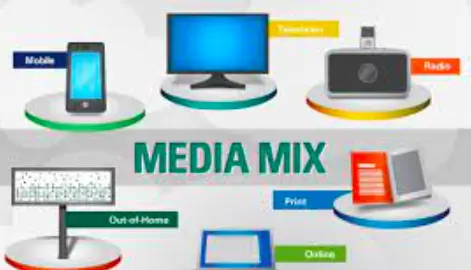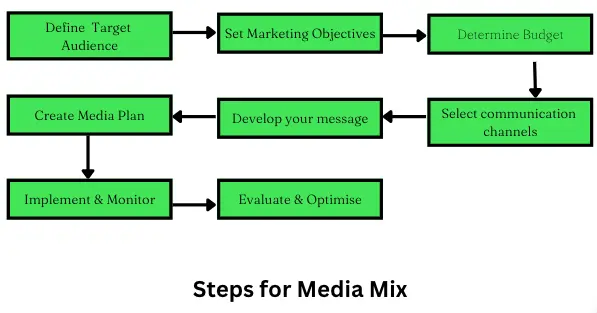Media Mix
Definition
Media mix refers to the combination of different communication channels and platforms a company or organisation uses to promote its products or services to a target audience.
Description
Media mix is a marketing strategy that combines various communication channels and platforms to promote a company’s products or services to a target audience. A media mix aims to maximise the effectiveness of advertising and promotional efforts by reaching consumers through different channels while minimising costs and achieving a greater return on investment.

Some channels that may be included in a media mix include television, radio, print media, digital media (such as websites, social media, and email), outdoor advertising (such as billboards and transit ads), and events and sponsorships. The channels used in a media mix will depend on factors such as the target audience, budget, and marketing objectives.
When developing a media mix, marketers must consider several factors. For example, they must identify the target audience and determine the most effective channels for reaching them. They must also consider the message they want to convey and ensure the selected tracks are appropriate.
Another important consideration is the budget. Different channels have different costs, and marketers must determine how to allocate their budget across various channels to achieve the most significant impact. They must also monitor and measure the effectiveness of each channel to ensure that they are achieving their marketing goals.
Importance of Media Mix
Media mix is an important marketing strategy that benefits companies and organisations. Here are some key reasons why media mix is important:
- Reaching a wider audience: By using a variety of communication channels, a media mix enables companies to reach a wider audience than they would through any single channel. This can increase brand awareness and generate more leads.
- Diversifying risk: Relying on a single communication channel can be risky, as changes in that channel (such as a decline in viewership or increased costs) can significantly impact a company’s marketing efforts. A media mix reduces this risk by spreading a company’s message across multiple channels.
- Maximising ROI: By using a combination of channels, companies can identify the most effective channels for reaching their target audience and adjust their budget allocation accordingly. This helps maximise their marketing efforts’ return on investment (ROI).
- Flexibility and adaptability: A media mix allows companies to adapt to changes in their marketing environment (such as changes in consumer behaviour or new communication channels) more easily. Companies can stay current and remain competitive by incorporating new channels or adjusting their mix.
- Increased engagement: Different channels have different strengths and can be used to engage audiences in different ways. A media mix enables companies to tailor their message to each channel and create a more engaging and impactful marketing campaign.
How to Prepare Media Mix?
Preparing a media mix involves several key steps. Here are some general guidelines to follow:

- Define your target audience: Identify your target audience and their characteristics, such as demographics, psychographics, and media consumption habits.
- Set your marketing objectives: Determine what you want to achieve through your media mix, such as increasing brand awareness, generating leads, or driving sales.
- Determine your budget: Establish a budget for your media mix, and allocate it among the different channels based on their effectiveness and costs.
- Select communication channels: Choose the most effective channels for reaching your target audience and achieving your marketing objectives. Consider factors such as reach, frequency, and impact.
- Develop your message: Craft a clear and compelling message that resonates with your target audience and is appropriate for each communication channel.
- Create a media plan: Develop a detailed plan that outlines the specific channels, message, timing, and budget for each component of your media mix.
- Implement and monitor: Execute your media plan, and track the performance of each channel. Monitor metrics such as reach, engagement, and conversions, and adjust your media mix as needed based on the results.
- Evaluate and optimise: Regularly evaluate the effectiveness of your media mix and make adjustments based on the data. Continuously optimise your media mix to achieve the best results possible.
The Future of Media Mix
The future of the media mix will likely be shaped by several trends and developments in the marketing landscape. Here are some potential future aspects of the media mix:
- Integration of artificial intelligence: Artificial intelligence (AI) will likely become more prevalent in the media as companies seek to personalise their messages and optimise campaigns through data analysis and machine learning.
- Emphasis on mobile and social media: Mobile and social media are already important components of the media mix. This trend will continue as more consumers use mobile devices and social media platforms to consume content and engage with brands.
- Greater use of video: Video is becoming increasingly popular as a medium for advertising and marketing. This will continue as more consumers consume video content on multiple platforms.
- Expansion of programmatic advertising: Programmatic advertising, which uses automated algorithms to buy and place digital ads, will likely grow in popularity as marketers seek to reach their target audiences more efficiently and effectively.
- Importance of data privacy and security: As consumers become more aware of data privacy and security issues, companies must be more transparent about collecting and using consumer data in their media mix.
- Rise of experiential marketing: Experiential marketing focuses on creating memorable experiences for consumers and will likely become more critical in the media mix as consumers increasingly prioritise experiences over products.
Example:
One example of a brand that has effectively used a media mix is Nike. Nike’s media mix combines a range of channels and tactics to reach its target audience and achieve its marketing objectives. Here are some examples of how Nike has used its media mix:
Television Advertising: Nike has used television advertising to build brand awareness and showcase its products. Their advertisements often feature high-profile athletes and compelling visuals emphasising the company’s focus on performance and innovation.
Social Media: Nike has a strong presence on social media platforms such as Instagram, Facebook, and Twitter. The company uses social media to engage with its customers, share content highlighting its brand values, and promote its products.
Influencer Marketing: Nike has partnered with influencers and celebrities to promote its products and build brand awareness. For example, the company collaborated with basketball star LeBron James to create a line of sneakers and apparel.
Content Marketing: Nike has developed a range of content marketing initiatives, including a dedicated website called Nike News, which features articles, videos, and other content related to the company’s products and brand values.
Experiential Marketing: Nike has used experiential marketing tactics to create memorable brand experiences for its customers. For example, the company made a pop-up running track in Manila that allowed runners to compete against a virtual version of themselves.
FAQs
What is a media mix?
A media mix combines different communication channels and tactics that a company uses to reach its target audience and achieve its marketing objectives.
Why is a media mix important?
A media mix is important because it allows companies to reach their target audience through various channels, increasing the likelihood of success. It also helps to spread risk by diversifying marketing efforts across multiple channels.
What factors should be considered when creating a media mix?
Factors that should be considered when creating a media mix include the target audience’s demographics, interests, and media consumption habits; the company’s marketing objectives; the available budget; the effectiveness and costs of different channels; and emerging trends and technologies.
What are some standard components of a media mix?
Common components of a media mix include television advertising, print advertising, radio advertising, social media, influencer marketing, content marketing, experiential marketing, email marketing, and search engine marketing.
How can the effectiveness of a media mix be measured?
The effectiveness of a media mix can be measured through metrics such as reach, frequency, engagement, conversion rates, and return on investment (ROI). Establishing clear performance indicators and tracking results is essential to continuously optimise the media mix.
How can a company optimise its media mix?
A company can optimise its media mix by monitoring and analysing the performance of each component, adjusting the mix as needed, and staying up-to-date with the latest trends and technologies in the marketing landscape. In addition, it’s important to continuously experiment, test and refine to maximise the effectiveness of the media mix.
Can a media mix be applied to any industry?
Yes, a media mix can be applied to any industry as long as a target audience needs to be reached and marketing objectives must be achieved. The channels and tactics used may vary based on the industry and target audience.





We would love to have your opinion.